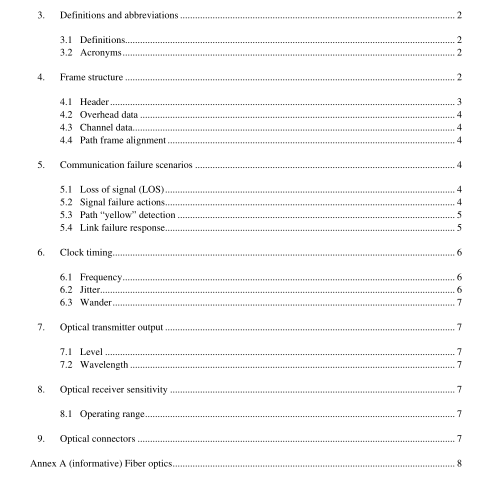IEEE C37.94-2002 pdf download.IEEE Standard for N Times 64 Kilobit Per Second Optical Fiber Interfaces Between Teleprotection and Multiplexer Equipment
This standard describes the interconnection details for N, where N = 1, 2…12, times 64 kilobit per second connections of teleprotection equipment to digital multiplexers using optical ber. Requirements for both physical connection and the communications timing are also included. 1.2 Purpose The purpose of this standard is to allow the interconnection of different vendors’ teleprotection equipment with different vendors’ multiplexer equipment, without any restriction on the content of the N times 64 kilobit per second data using up to 2 km of 50 or 62.5 micrometer multimode optical ber.
2. References The following standard contains provisions, which through reference in this text constitute provisions of this standard. At the time of this publication, the editions indicated were valid. All standards are subject to revision, and parties to agreements based on this stardard are encouraged to investigate the possibility of applying the most recent editions of the standards indicated below. Members of the IEC and ISO maintain registers of currently valid International Standards.
IEC-60874-10-1 (1997-06) Connectors for optical bres and cables– Part 10-1: Detail specication for bre optic connector type BFOC/2.5 terminated to multimode bre type A1
3. Denitions and acronyms
3.1 Denitions For the purposes of this standard, the following terms and denitions apply. The IEEE Authoritative Dictionary of IEEE Standards Terms , Seventh Edition [B2] 2 , should be used for terms not dened in this clause.
3.1.1 jitter: A term used to describe perturbations in the timing of data bit transitions when the frequency of the perturbations is greater than 10 Hz.
3.1.2 multimode optical ber: An optical ber that has a relatively large core, in which light bounces off the walls of the core. This results in multiple signal paths through the ber, which limits the maximum signaling rate more and more as the ber length increases.
3.1.3 multiplexer equipment: A device that allows the transmission of a number of different signals simultaneously over a single channel or transmission facility.
3.1.4 teleprotection equipment : Equipment that provides the interface between the protective relay and a communications circuit.
3.1.5 unit interval (UI): Time duration equal to the reciprocal of the bit rate.
3.1.6 wander: A term used to describe perturbations in the timing of data bit transitions when the frequency of the perturbations is less than 10 Hz.
3.2 Acronyms BER bit error rate CRC cyclic redundancy check LOS loss of signal LOF loss of frame ppm parts per million RDI remote defect indication 4. Frame structure The frame structure is designed to allow the passage of information in packet format from the multiplexer to the teleprotection equipment and from the teleprotection to the multiplexer equipment.
The format was chosen so:
a) The frame is a valid International Telecommunications Union (ITU-T) recommendation G.704 pattern from the standpoint of framing and data rate. However, the data structure is not a standard data format.
b) The bit pattern would have approximately equal ones and zeroes (for transmission through ac- coupled optical circuits).
c) The frame would have an easily detected bit pattern for frame synchronization. d) The frame structure is identical in both directions. The frame is the same size and format regardless of the number of 64 kilobit per second timeslots being utilized.
The frame is 256 bits and is repeated at a frame rate of 8000 Hz.
The resultant bit rate is 2048 kilobit per second.
The frame consists of three sections: the header, the overhead data, and the channel data arranged as shown in Figure 1.IEEE C37.94 pdf download.IEEE C37.94-2002 pdf download
IEEE C37.94-2002 pdf download

Leave a Reply